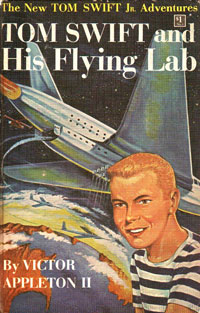Tom Swift, where are you?by Anthony Young
|
| The timing of the Tom Swift Jr. series was fortuitous. The launches of the Sputniks and the resulting Cold War space race helped to spur sales of the Tom Swift books even though only a third of the titles focused on outer space. |
The location for each new title could range from the depths of the oceans in his Deep-Sea Hydrodome (1958), crossing the vast continents of the Earth in his Triphibian Atomicar (1962), or exploring outer space in his Cosmotron Express (1970). The book cover illustrations were visual grabbers and were instrumental in impulse buying. With a hardbound cover price between $1.00 to $2.00 during the 1950s and 1960s, the books were an affordable escape for a budding engineer or future rocket scientist.
The timing of the Tom Swift Jr. series was fortuitous. The launches of the Sputniks and the resulting Cold War space race helped to spur sales of the Tom Swift books even though only a third of the titles focused on outer space. TV network coverage of each Mercury, Gemini, or Apollo launch was avidly watched, immediately followed by a trip to the basement to continue work on the next model rocket project. It was a fascinating time for a young man to be growing up. It all culminated on July 20, 1969 with the landing of Neil Armstrong and Buzz Aldrin on the Moon.
When Commander David R. Scott and James B. Irwin drove the first Lunar Roving Vehicle across the Hadley-Apennine region of the Moon in 1971, that year also marked the end of the Tom Swift Jr. series. I had no idea then that I would one day write a book about the history of the LRV, but I don’t doubt my interest in reading the Tom Swift Jr. series motivated me to one day turn my interest toward writing.
The Tom Swift series was revived in the 1980s, again in the 1990s, and most recently in 2006. The character is certainly an enduring one as the writers of Tom Swift manage to recreate him to keep pace with, if not ahead of, the times. This last series is no longer in print. As the shuttle era comes to an end and America waits for several years with no astronauts being launched from Kennedy Space Center, Tom Swift may have to pause until Project Constellation ramps up. With the advent of sophisticated computer games and other forms of online entertainment, the lure of science fiction for young readers is not what it was decades ago. However, perhaps the lull in launch activity will present a market need for a young inventor and engineer by the name of Tom Swift to create even more fantastic machines and embark on exciting adventures for a new generation of readers.
